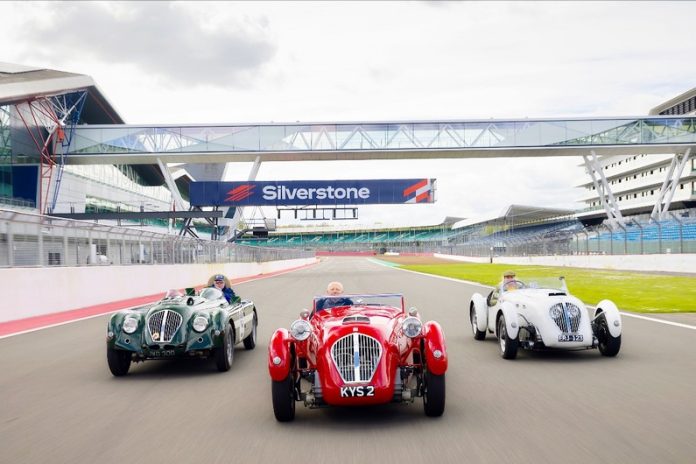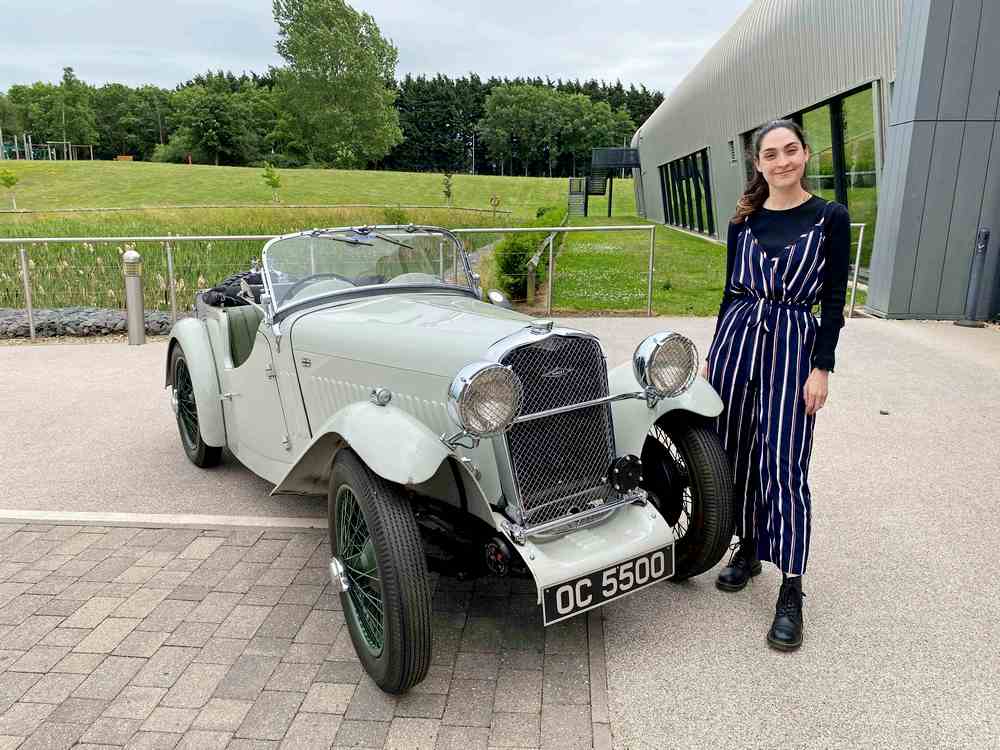One of the benefits of running this website is that it brings me into contact with some stunning motor cars. This is mainly via auction sites which offer cars that only the mega-rich can afford. Inevitably, these are rarely seen by even the keenest of car enthusiasts. In this article, I want to bring one such car to your attention – the Alfa Romeo Tipo 33 Stradale.
The Beginning
Alfa Romeo is a name that evokes all the noblest of achievements in automotive history, especially in the motorsport arena. Sadly, the majority of those achievements were recorded many decades ago. Since the 1960s/70s, it has been left to Ferrari to uphold Italy’s reputation as the Country from whence originates exotic and successful automobile art, in form and construction. I haven’t forgotten Lamborghini but it hasn’t got the racing pedigree of Alfa Romeo and Ferrari.
Where do you think Enzo Ferrari learned his trade? yes, that’s right, Alfa Romeo. In the early 1920s he was a works driver for Alfa Romeo before realising that his greatest skill lay in the field of Team Management, a role he first fulfilled at Alfa Romeo.
Alfa Romeo, or, as it was when founded, ALFA (Anonima Lombarda Fabbrica Automobili) was the phoenix that emerged from the failure, in 1909, of SAID (Società Anonima Italiana Darracq), the Italian satellite of the French car company. Cavaliere Ugo Stella was a prominent Italian investor in SAID and when it failed he joined with other investors to form ALFA with a view to building cars that were more suitable to the Italian market than had been the Darracqs. Car production was interrupted by the First World War and in 1915 an entrepreneur from Naples, by name of Nicola Romeo, bought into the company. He changed the name of the company to ALFA ROMEO; subsequent engineers and designers turned the company into one of the most revered in the automotive world. To be fair, as with so many great marques, Alfa Romeo’s halcyon days are in the past; having said that, I would like to give credit to Valtteri Botas and Guanyu Zhou for doing a creditable job in campaigning the current Alfa Romeo F1 cars, even though we all know that, technically, they are Saubers.
Whilst mentioning Formula One it is only right that I should remind you that it was an Alfa Romeo P2 that won the inaugural ‘Automobile World Championship’ in 1925. Also, in 1950, an Alfa Romeo Tipo 158 (Alfetta), driven by Guiseppe Farina, won the first F1 World Championship. This was replicated the following year when Juan Manuel Fangio won the Championship in his uprated Alfetta (Tipo 159). After that Alfa Romeo “retired”, undefeated, from Formula One racing in order to concentrate on building cars for the motoring public.

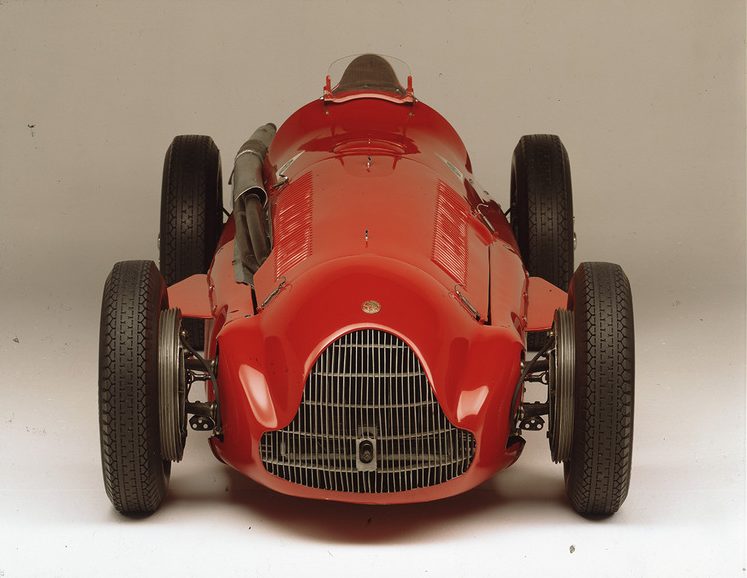
Badges,
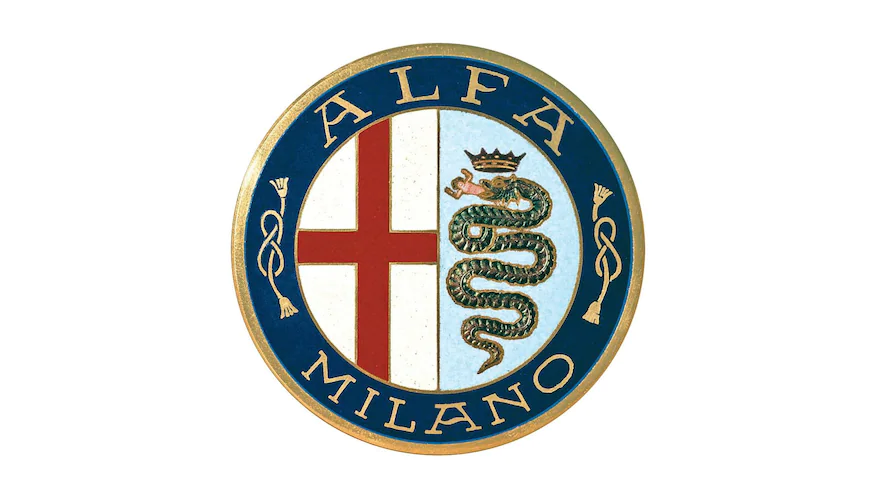
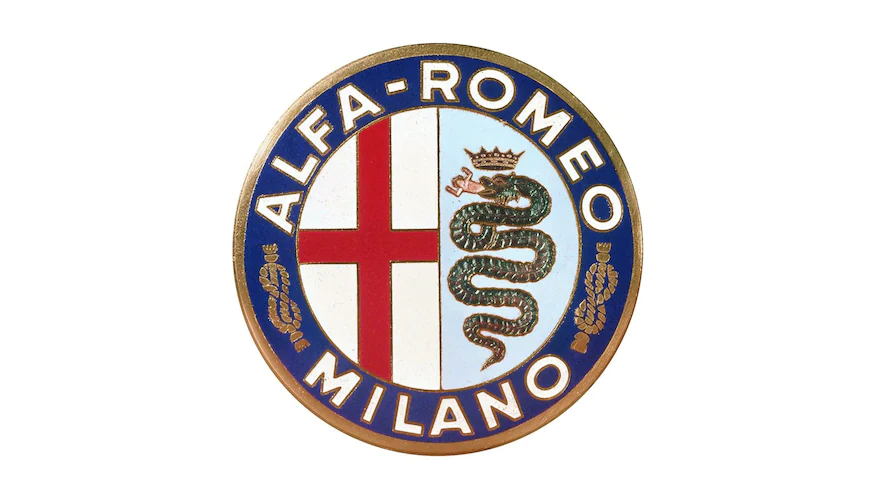
Government Ownership
In 1921 the bank that had supported Signore Romeo’s investment in ALFA failed and all the companies in which it had holdings became wards of the Italian Government. This sounds fairly benign and sensible but this action took place against a background of political turmoil in the years leading up to Mussolini establishing his fascist government. The Italian Government, in all its guises, before and after WWII, had ultimate control of Alfa Romeo up until the company was bought by Fiat in 1986. To most people, Government ownership of motor companies conjures up images of fairly boring ‘safe’ designs aimed at “ordinary” motorists who want to get from ‘A to B’ in a safe, reliable and comfortable manner: blistering acceleration, high top speed and above all, “seat of the pants” road-holding and feedback, all wrapped in a “head-turning” body style, are not high on the list of attributes sought by these buyers. And yet, those are the attributes embodied in Alfa Romeo designs from the 1920s to the 1970s. These were the designs that established the marque’s enviable reputation and are the reason why Fiat has kept the “halo” brand alive, despite poor sales in recent decades. The Italian government may not have made any profit from its ownership of Alfa Romeo but it was paid back many times over in terms of generating “National Prestige”.
Alfa Romeo Tipo 33
I could have chosen any number of outstanding Alfa Romeo cars to write about but the one that has particularly captured my imagination is the 33 Stradale. Here is the story of that car –
Alfa Romeo conceived the Tipo 33 (T33) as a mid-engined sports racing prototype in the early 1960s, the first car being created in 1965. Initially, it was specified with the 1.6 Ltr. DOHC inline 4cyl. engine that had powered the Giulia TZ2 to so much success in the early 1960s. T33 featured an interesting chassis design with two large-diameter side tubes joined together in an ‘H’ pattern by a tubular cross-member. The idea was to use the tubes as fuel tanks, to that end, the assembly was riveted together and lined with plastic to prevent leakage of the volatile fuel. Front and rear subframes carrying suspensions etc. were fixed to this central core. Before the T33 was entered into competition it was transferred to Autodelta for development. Auto-Delta was a special tuning company, majoring in Alfa Romeo cars, founded in 1961 by ex-Ferrari engineer, Carlo Chiti. Autodelta SpA, as it became known, was, in 1963, absorbed into Alfa Romeo, fulfilling the role of the company’s Competitions Department. Autodelta had been working on a 2.0 Ltr., aluminium, dry-sump, 90º V8 engine, it was this engine that was incorporated into the T33 design. In this configuration the T33 made its competition debut at the 1967 Fleron, Belgium, Hillclimb. Driven by Teodoro Zeccoli it set the fastest time of the day, it had clearly made its mark. As a result of this victory, the T33 became known as the T33 ‘Fleron’.
After extensive testing at Alfa Romeo’s Balocco test track, Autodelta developed a new model for the 1968 season. The main changes, over the 1967 design, resulted in improved aerodynamic efficiency and weight distribution. The latter was achieved by relocating the water and oil radiators behind each side of the driver’s cockpit. The car’s handling was dramatically improved as was cooling of the engine, brakes and cockpit. Both coupe and spyder versions were built, to suit the particular races they were entered in.
The revised car was designated T33/2 and made its debut at Daytona with three examples competing in the famed 24-hour race in February 1968. All three T33/2’s finished, claiming victory in the up to 2.0Ltr. class as well as an impressive 5th, 6th and 7th overall. Thereafter the T33 carried the designation ‘Daytona’. Alfa now felt confident that they had a car that would challenge the hitherto dominant Team Porsche for the up to 2.0 litres class of the World Sportscar Championship. Another notable result in 1968 was achieving 4th, 5th and 6th in that year’s, delayed, 24 Heures du Mans. For the 1968 Nurburgring 1000 KM. one of the cars, race number 5, driven by Udo Schütz and Lucien Bianchi was fitted with an enlarged 2462 cc. V8 engine; it finished 4th in the up to 3.0 Ltr. class and 7th overall, beaten by a 2.0 Ltr. T33/2 (car number 15) driven by Nanni Galli and Nino Vaccarella that won the 2.0 Ltr. class.
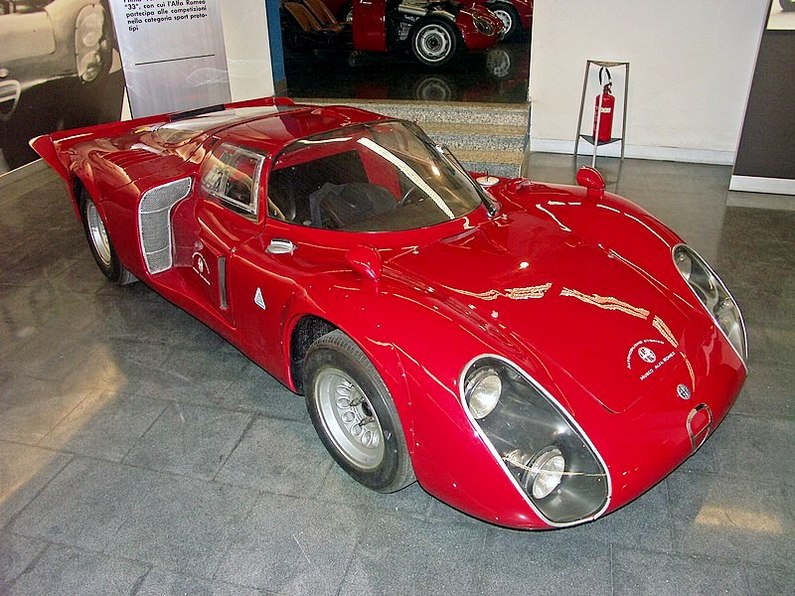
At the end of the 1968 season, Alfa Romeo had finished third in the International Championship for Makes. A very promising start indeed. A total of 28 cars were built during 1968, allowing the T33/2 to be homologated as a Group 4 (minimum annual production of 25 cars) Sports Car for 1969.
As well as campaigning the T33/2 during 1968, Autodelta were busy designing an improved version for the 1969 season. Logically, this car was designated T 33/3; class wins in the up to 2.0 Ltr. category were all well and good but Autodelta, supported by Alfa Romeo management, had greater ambitions – outright winner of the World Sportscar Championship for makes! To achieve this goal the V8 engine would have to be enlarged again this time to 2998 cc. This enlarged engine produced 400bhp (298 KW) putting it against the Porsche 908 and Ferrari 312P. As well as the enlarged engine T33/3 had a full monocoque body/chassis which brought greater rigidity and better road holding.
Two T33/3s made their debuts in the 1969 12 Hours of Sebring. Neither car finished that race, one retiring on lap 15 and the other on lap 17, both with overheating problems. Although entered, they did not take part in that year’s Le Mans race as a respectful gesture to Lucien Bianchi and his family; Lucien died as a result of a crash during practice for that event. The car took a couple of wins in smaller competitions but overall the 1969 season was not a successful one and Alfa Romeo was placed seventh in the 1969 International Championship for Makes.
In 1970 the bigger 5.0L Porsche 917 and Ferrari 512 dominated, yet Toine Hezemans and Masten Gregory took third overall at Sebring, and Andrea De Adamich and Henri Pescarolo won their class in the 1000km Zeltweg, finishing second overall. Also in 1970, an Alfa T33/3 was one of the cars featured in Steve McQueen’s film ‘Le Mans’, released in 1971.

Alfa Romeo Tipo 33/TT/3
The 1971 FIA World Sports Car Championship season saw Alfa Romeo and Autodelta competing with its updated Tipo 33/TT/3 car. Taking design and engineering cues from their competition at Ferrari and Porsche, Alfa Romeo’s latest race car earned its name courtesy of its tubular chassis (Telaio Tubolare in Italian). An all-new steel spaceframe chassis replaced the previous car’s sheet-aluminium monocoque. The engine fitted in the Tipo 33/TT/3 was an updated and enhanced version of that previously seen in the Tipo 33/3, now boasting an impressive 440 bhp at 9,800 rpm. Thanks to its redesigned cylinder heads, this high-revving quad-cam, 36-valve V8 engine was producing the same power as Ferrari’s much heavier 12-cylinder unit! There was also a new five-speed gearbox, the wheelbase was increased, and new safety fuel tanks were fitted. However, the new bodywork did bear similarities to the previous design. Initially, the car weighed a mere 600 kg, but to meet regulations, the weight was increased to 650 kg.
The Alfa Romeo racing effort was finally successful. Rolf Stommelen and Nanni Galli won their class at the 1000km Buenos Aires (followed by De Adamich and Pescarolo), before taking another class win (and second overall) at Sebring. De Adamich and Pescarolo later won outright at the 1000km Brands Hatch, a significant result against the “invincible” 917s. They then took a class win at Monza (where Alfa Romeo took the three podium slots in the prototype class) and another one at Spa. At the Targa Florio, Vaccarella and Hezemans won outright, followed by teammates De Adamich and Gijs van Lennep. Hezemans and Vaccarella won their class at Zeltweg, and De Adamich and Ronnie Peterson won overall at Watkins Glen. Alfa Romeo finished the season in second place in the championship.
In 1972 the 5 litre Group 5 Sports Cars were banned and the 3 litre cars of Alfa Romeo, Ferrari and Matra, redesignated as Group 5 Sports Cars, competed against each other for outright victories. It was not a particularly successful year for Autodelta in the World Sportscar Championship, they realised that something completely different was required in the engine department.
T33/TT/12
Thus, T33/TT/12 appeared in 1973 with the Carlo Chiti-designed 12 cylinder 3.0Ltr. horizontally opposed engine (500 bhp). Beacuse it was a new, unproven engine the 1973 season was virtually given over to development time with an eye on the 1974 season. That season started well with a TT/12 taking first place at the first race, the Monza 1000 km. That was the only outright victory that year but second places were achieved at Nurburgring, Imola and Österreichring, resulting in a second place championship finish. It wasn’t until 1975 that, after years of trying, Alfa Romeo finally won a World Championship for Makes title. The season was one of almost total domination with seven wins in eight races. Winning drivers were: Arturo Merzario, Vittorio Brambilla, Jacques Laffite, Henri Pescarolo, Derek Bell and Jochen Mass. Autodelta turned its attention to other things in 1976 and the car was rarely used in competitions. However, they did have plans for returning to the World Sportscar Championship in 1977. The designers never seem to have been quite satisfied with the chassis that they designed, even though they proved to be ultimately successful. For the 1977 season, yet another chassis was introduced – the Scatolato (Boxed) giving the cars its SC designation – T33/SC/12.
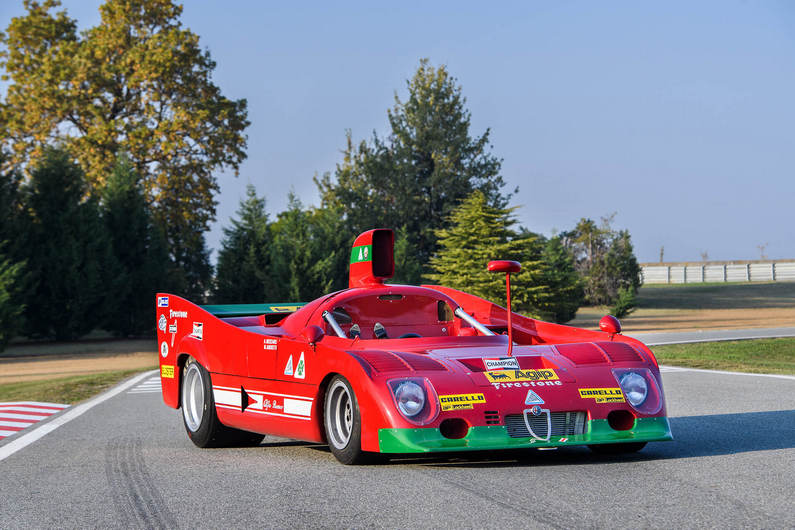
T33/SC/12
The 3.0 L flat-12 engine now produced 520 bhp (390 kW) making it highly competitive. With this car, Alfa Romeo won the World Sportscar Championship for makes for the second time. Driven by Arturo Merzario, Jean-Pierre Jarier and Vittorio Brambilla, it won every race in the series. At the Salzburgring the car reached an average speed of 203.82 km/h (126.6 mph). In that same race, Arturo Merzario finished second in a T33/SC/12 fitted with a 2134 cc turbocharged engine producing 640 bhp. This was Alfa’s first twin-turbocharged 12-cylinder engine, it was introduced around the same time as Renault’s Formula One turbo engine. Each bank of the Alfa Romeo’s engine was fed by its own turbocharger this is a feature that was adopted by many racecar makers in the following years. The flat-12 engine was later used on Brabham-Alfa BT45, BT46 and Alfa Romeo 177 F1 cars.
ALFA ROMEO 33 STRADALE
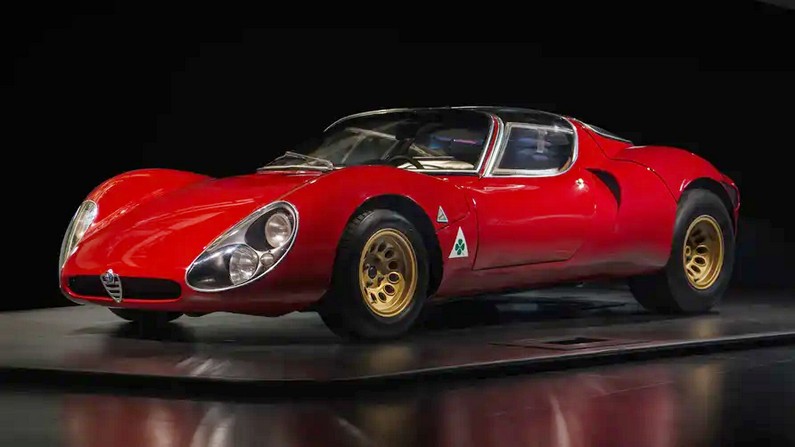
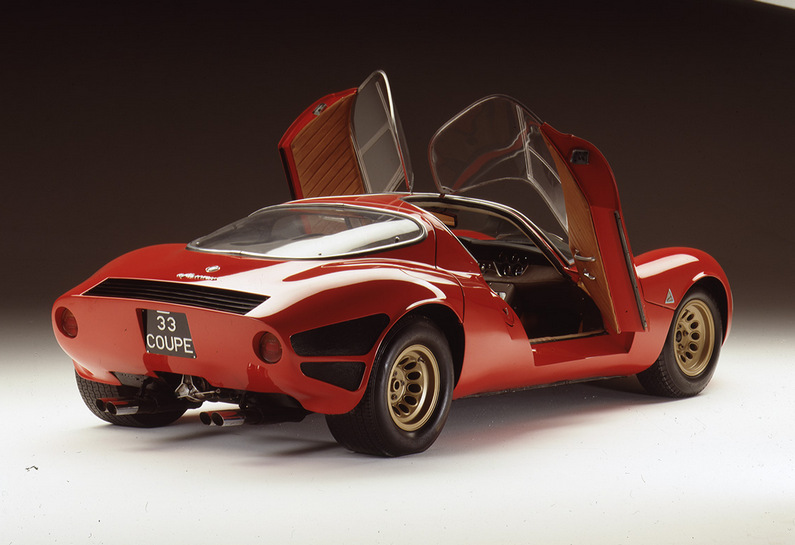
When I first set out to write this article it was this car that was my main motivation. I am rather surprised that I have spent so long describing the sports racing car and later derivatives, from which the Stradale was developed. In my view, it was essential to mention the Stradale’s racing heritage but it seems that I got caught up in that part of the story to a greater extent than I could have imagined possible. If that section has captured your imagination too then that’s good, if not and it is the “road car” that has the greater appeal, then, here it is now. However, I would ask you to bear in mind that this car would not have been created if it were not for Autodelta’s racing programme. ‘Stradale’ is Italian for “street legal” and was a term used by most Italian race car manufacturers to describe ‘homologation’ derivates. In the Alfa Romeo case, this prosaic term was, unofficially, adopted as the car’s name.
It is thought that the reason why the Stradale car was conceived is to allow Alfa Romeo to meet the minimum production requirements (50) for the Group 4 category of the World Sportscar Championship. However, events overtook the project, with the Group categories changing and with them, Autodelta’s ambitions. In reality, it is difficult to imagine that Autodelta could have built fifty cars in the time available and even if they did, the resultant price of each car would have been prohibitive. That was the case with the near eighteen cars that were built. Of course, they are now much sought-after “collectors cars”. **
The car that emerged from the Autodelta, Settimo Milanese, workshops, designed by Franco Scaglione and built by Carrozzeria Marazzi, was a gorgeous two-seater that is regarded today as the first modern supercar and one of the most beautiful designs of all time. The car was first shown to the public at the post Italian GP race Monza Sports Car show in September 1967 and again at the Paris Salon de L’Auto on 5 October 1967.
The two prototypes carry the project’s original serial numbers, 105.33.xx. However, the Tipo 33 racing and production Stradales got 750.33.0xx (racing) and 750.33.1xx (Stradale) chassis numbers. Marazzi claims to have built 18 chassis. 5 of them were used for 6 concept cars (one chassis was used twice) by Pininfarina, Bertone and Giugiaro/ItalDesign. Eight are confirmed with Scaglione’s beautiful bodies. The rest are experimental or unconfirmed at this point. The five concept cars are now part of the Alfa Romeo Museum, located to the northwest of Milano.
Body and chassis
The 33 Stradale is one of the first production vehicles to feature forward-hinging dihedral (butterfly) doors. It also features windows which seamlessly curve upward into the ‘roof’ of the car. It has an aluminium body mounted on an aluminium tubular chassis. As a result of being built by hand, not one car is exactly the same, this is not at all unusual for limited production cars. For example, the first two cars (prototypes) had twin headlights, replaced for production cars by single headlights, to meet legislative requirements. The position of the windscreen wiper, and even the number of them, is another thing that differentiates each example from the others. A host of other small differences were introduced over the two years the cars were being built.
The rest of the chassis specification includes 13-inch Campagnolo magnesium wheels with widths of eight inches at the front and nine inches at the rear. Girling ventilated disc brakes are fitted all round, with the rears being located inboard in order to reduce unsprung weight. The front and rear suspensions are taken directly from the race cars, with upper and lower control arms in front and double trailing arms in the rear, incorporating coil-over spring units along with substantial antiroll bars.
Engine and transmission
The race-bred engine bore no relation to the mass-produced units in Alfa’s more mainstream vehicles. It derives from the engine fitted to the T33 competition cars but differed in many details. For example, The Stradale engine has four chain-driven camshafts as opposed to the race cars gear driven ones. Race engineer, Carlo Chiti, designed an oversquare bore x stroke of 78 mm × 52.2 mm (3.07 in × 2.06 in) dry-sump lubricated all-aluminum 1,995 cc (2.0 L) 90º V8 engine that featured SPICA fuel injection, four ignition coils and twin spark plugs per cylinder. It had a rev-limit of 10,000 rpm and a compression ratio of 10.5:1, producing 230 PS (227 bhp; 169 kW) at 8,800 rpm and 206 N⋅m (152 lb⋅ft) at 7,000 rpm of torque in road trim.
Performance –
Top speed – 162 mph – Acceleration – O- 62 mph. 4.2 secs. Impressive!
** And the price that you would have to pay if one, unusually, came to the market? – between $10,000,000 and $20,000,000!
I hope that you have enjoyed that journey back to the dynamic days of Alfa Romeo and Autodelta’s activity.
Nick
© carsceneinternational.com This copyright applies to both the text and all the photographs shown in this post.



